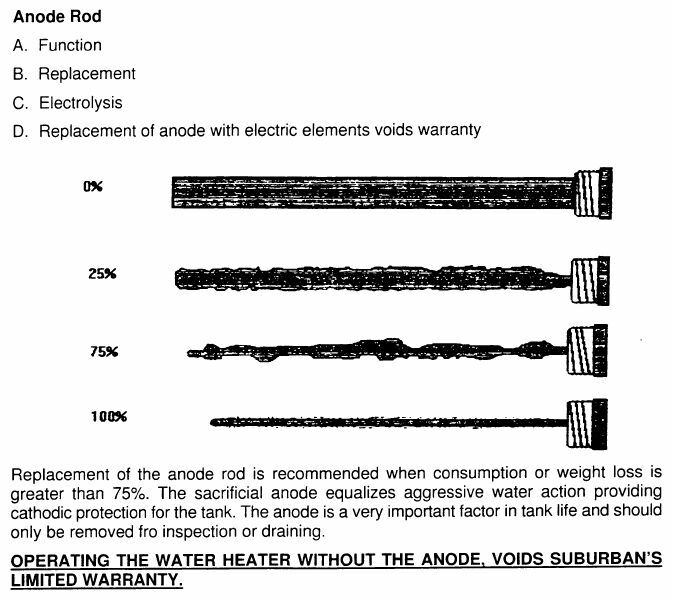As a follow up question, if in between trips, (maybe just couple of weeks) if you drain the low point valves does this get rid of the water in the water heater or is there still a need to remove the anode?
Your water heater fills from the bottom. Under pressure, the hot water leave the tank from the top. So, if you simply open the hot water low point drain, no... the tank will never empty as the "outlet" of the tank is at the top.
If you open the low point drain, it won't drain anything either, unless you open cold faucet, or all the cold faucets. Otherwise, the lines are in a vacuum and will never drain. The water heater will never drain either unless the hot water faucets are opened also.
Now, depending on your unique camper (none are the same, even with the same model number), it's possible the low point drain will not actually drain the water from the hot water tank.
Your best bet to drain the water heater is to pull the drain plug or anode rod. That way, you know it's empty.
Here's a tip. If you pull the anode rod, after it drains, insert the anode back into the tank and finger tighten it. You don't need to "wrench" tighten it back up. Finger tight is good enough. Just make sure you insert the anode back in. Why? Because, if you leave the anode out, the threads of the tank AND the threads of the anode rod will rust up.... fast.... and real bad ... making it near impossible to insert again.
One more comment...
In the past, I use to empty my fresh water tank, and my water heater tank every time the camper moved. That meant, draining everything from home to campsite #1. Then campsite #1 to campsite #2. Then campsite #2 to home again.
I did this on 3 different travel trailers.
When we got our fifth wheel, I quite draining the water heater and I now always leave at least, a few gallons of water in the fresh water tank.
We use our fifth wheel much, much more than we ever used travel trailers, so draining the water heater is not so practical any more. Plus the extra weight for water in the fifth wheel doesn't affect the "feel" of the tow, like it profoundly did in all my previous travel trailers.
Once the fifth wheel is at home, we still use the camper 24x7 full time. So, draining just makes no sense now.
Of course, for winterizing, everything is drained completely. I did change the anode rod this year (after almost 5 years of use on the same one... and it still had at least 50% life left). When I inserted the new one, I didn't use Teflon on the threads, and I noticed a small drip, causing the water pump to kick on and sputter occasionally.
So, just a couple days ago, after returning home from a 2 week "outing" I decided to go ahead and put the Teflon on the threads. When I pulled the rod out, I noticed it had a slight slimy coating on it. Mostly, the rod is dried out, even wet, even chalky. So, this is a first.
As we are home right now (for the next 3 weeks before heading out for the next 2 and 1/2 months (End of June, July, August, and part of September), I'll go ahead and re-sanatize the water heater and try to clean it out real good. I think the slimy texture might be the start of something growing, I don't want in there.
Maybe I should drain it more often! (That's my point).
So, anyway, there's my story.

